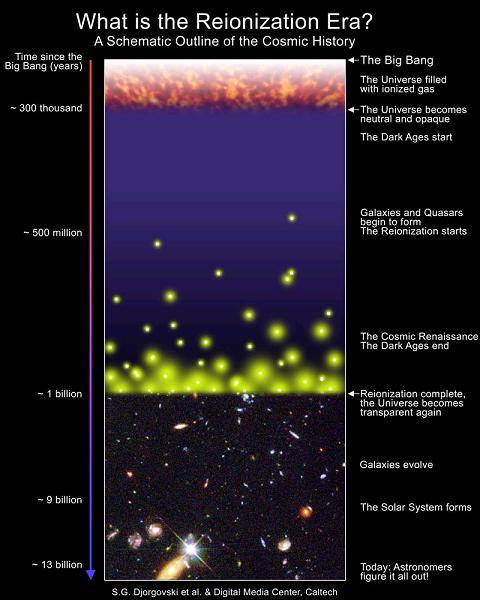380,000 years after the Big Bang, the Universe cooled from being
a hot soup of plasma, to a temperature where protons and
electrons could combine to form atoms. This calm period of
neutral hydrogen in universal history didn’t last for long
however. The neutral hydrogen atoms were ripped apart once more,
by a mechanism that would go on to reionize the entire Universe,
a process that eventually ended a billion years after the Big
Bang.
It is thought the first
stars that
formed prior to the reionisation epoch probably pumped out some
fierce ultraviolet radiation, ionizing the neutral hydrogen, but
a new (controversial) theory has been put forward. Did dark
matter have a role to play in the reionisation the Universe?
As 85% of the Universe is composed of a type of matter we have
yet to fully account for, it seems only natural that scientists
would be looking into the possibility that dark matter had a
role to play soon after the Big Bang. Although scientists are
fairly confident that the reionisation period was driven by the
emissions from the very first stars,
there are some observational factors that could suggest dark
matter annihilation might have had a role to play in the
evolution of the Universe.
This is according to Dan Hooper and Alexander Belikov from
Fermilab in Batavia, Illinois, in any case. In their theory
recently published, the researchers examine the physics behind
dark matter annihilation as the mechanism that drove the
reionisation epoch.

In Hooper and Belikov’s work, they focus on dark matter that is
theorized to have clumped together under gravitational
attraction as the Universe cooled during the neutral hydrogen
era (known as the “Dark Ages” - the Universe would have been
opaque due to lack of stars and lack of electromagnetic
radiation). When the dark matter during this time clumped, it is
predicted to annihilate. During dark matter annihilation, high
energy gamma-rays are predicted to be generated. Where
gamma-radiation goes, ionization of matter is sure to follow.
“A single gamma ray might reionise 1000 hydrogen atoms,”
says Hooper. “The mechanism could easily have reionised the
universe.”
By their reasoning, rather than emissions from stars that may
have been forming at the start of the reionisation epoch, a far
more potent ionization mechanism could have flooded the
Universe. However, some scientists are skeptical of this idea.
“We have no evidence yet that any dark matter has ever
annihilated,” says Charles Bennett, principal investigator
on NASA’s WMAP satellite, which has been studying the
reionisation epoch. “I am not saying it is wrong, but it
sounds a bit too contrived for me to eagerly accept it.”
Bennett sees the dark matter argument as one mystery (reionisation)
being explained by another mystery (does dark matter even
annihilate?).
For now, the idea that dark matter may have been the underlying
mechanism ionizing our Universe remains highly theoretical. But
Hooper is eager to study the data from ESA’s upcoming Planck
mission as this observatory will be able to study how
reionisation proceeded with time. “The time signature of
dark matter reionisation will be different from that brought
about by stars,” says Hooper.
Source: New
Scientist